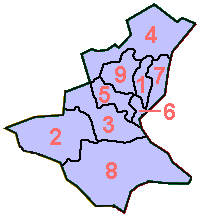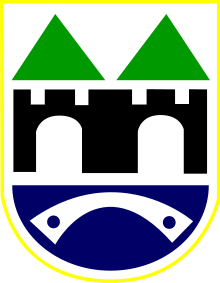Novi Grad, Sarajevo
Novi Grad (Serbian Cyrillic: Нови Град; pronounced [nôʋiː grâːd], "New Town") is a municipality of the city of Sarajevo, Bosnia and Herzegovina. It is the westernmost of the four municipalities that make up the city of Sarajevo.
Novi Grad Нови Град New Town | |
|---|---|
Sarajevo Novi Grad in May 2010 | |
 Coat of arms | |
 Location of Novi Grad, Sarajevo within Bosnia and Herzegovina. | |
| Coordinates: 43°50′56″N 18°22′16″E | |
| Country | |
| Entity | Federation of Bosnia and Herzegovina |
| Communities | 23 |
| Government | |
| • Municipality president | Semir Efendić (SDA) |
| Area | |
| • Total | 47,2 km2 (182 sq mi) |
| Population (2013 census) | |
| • Total | 124,471 |
| • Density | 2,637.1/km2 (6,830/sq mi) |
| Time zone | UTC+1 (CET) |
| • Summer (DST) | UTC+2 (CEST) |
| Area code(s) | +387 33 |
| Website | www |

History
During the 1970s, Sarajevo was undergoing a rapid economic and cultural development, with great expansion focused on population and industry. Novi Grad was a direct result of this period of heavy growth, in which many acres of previously unused land were transformed into Socialist urban centres filled with apartment buildings. By the time the Novi Grad municipality was formally recognized, it had some 60,000 citizens, in 18 neighbourhoods.
According to the 1991 census, the municipality of Novi Grad had 136,746 citizens. Four years of Bosnian War brought that number down tremendously. Some sections of Novi Grad were among the first to be occupied by the aggressors, while the city was repeatedly showered by mortar shells. Of the municipality's 33,517 residential buildings, 92% were damaged during the Siege of Sarajevo.
Novi Grad has since made a fantastic recovery. Although many bullet holes and mortar shell impacts are visible throughout the municipality, it is overall healthy and functioning. As the most modern part of Sarajevo, Novi Grad is also ground to many new developments, such as the Bosmal City Center.
Demographics
1971
111,811 total
1991
136,616 total
- Bosniaks - 69,430 (50.82%)
- Serbs - 37,591 (27.51%)
- Croats - 8,889 (6.50%)
- Yugoslavs - 15,580 (11.40%)
- Others - 5,126 (3.77%)
2002
According to the 2002 estimate, today the municipality of Novi Grad has 122,636 citizens, of which around 94% are Bosniaks, 2% Serbs and 4% Croats.
2005
In 2005, 86% of population of the municipality were ethnic Bosniaks.
Communities and neighborhoods in Novi Grad
- Boljakov Potok
- Staro Hrasno
- Otoka
- Mojmilo
- Švrakino selo Švrakino selo
- Aneks
- Alipašino polje-A Faza
- Alipašino polje-B Faza
- Alipašino polje-C Faza
- Saraj Polje (Vojničko Polje)
- Olimpijsko selo Mojmilo
- Dobrinja A
- Dobrinja B
- Dobrinja C
- Dobrinja D
- Buća potok
- Dolac
- Alipašin Most II
- Alipašin Most I
- Briješće
- Sokolje
- Dobroševići
References
- "Census of population, households and dwellings in Bosnia and Herzegovina, 2013: Final results" (PDF). Agency for Statistics of Bosnia and Herzegovina. June 2016. Retrieved 3 August 2016.
.jpg)
